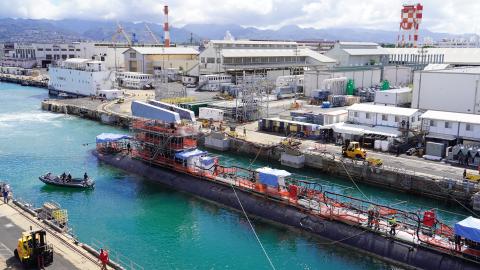View full PDF with maps and figures.
Introduction and Summary
The Geopolitical Threat
Geopolitical competition between the United States and China has prompted broad policy reassessments in many industries associated with military and economic security. In no strategically important sector is China’s advantage over the US more pronounced than in the commercial maritime industry. Using extensive government support and other advantages, China has created a commercial shipping and shipbuilding powerhouse of extraordinary scope and scale. This gives Beijing unmatched control over the circulatory system that feeds our global economy—the ships, ports, and other aspects of these essential links in international trade. China’s commercial fleet (including ships owned in Hong Kong) is the largest in the world, numbering more than 10,000 large vessels and many thousands of small cargo and fishing vessels. Those vessels exert complete control over China’s domestic shipping markets;1 push de facto control over waters that extend beyond the People’s Republic of China’s legal boundaries; harass US Navy, Coast Guard, and allied ships; and serve as a naval reserve that would provide crucial support in any conflict. With substantial purchases from customers in the US and Western-aligned countries, China’s commercial shipbuilding industry is now slated to produce more ships than the rest of the world combined. Billions, if not tens of billions, of dollars flow each year from these purchases to programs and shipyards that indirectly strengthen the People’s Liberation Army Navy (PLAN), which is increasingly competitive with the US Navy.
In contrast, almost no American commercial ships operate in Western Pacific markets. Should a conflict with China break out, America’s total international commercial fleet is much too small to meet basic US military resupply requirements, even if America deployed all of its commercial ships to the region. The US is simply a customer of global logistics supply chains and has no direct ability to prevent China from abusing them if the PRC chooses to do so. Not nearly enough of America’s shipbuilding industrial base receives support from commercial building and repair work financed by private sector customers, rather than from government work paid for by US taxpayers.
Just as China is striving to neutralize America’s advantages in certain strategically important sectors, American policymakers are assessing changes to mitigate risks where China has the advantage. In a recent report, I explored China’s advantages in the commercial maritime sector and recommended specific policy changes that would, among other things, triple the number of US flag ships with American mariner crews trading internationally.11 That fleet would carry the most advanced technology for crew safety and propulsion, and it would consist of ship types and deployments configured to maximize the fleet’s value to American military and economic security. The plan would also phase in a requirement that American shipyards build those ships. This would provide a consistent demand signal enabling investment in technologies and process efficiencies that would improve performance and position the industry to scale up quickly if necessary in a conflict.
American national security interests thus demand a significant update of US policies governing commercial shipbuilding and the international shipping industry to help deter Chinese aggression and better secure maritime supply lines, both in peacetime and in the event of a conflict. The same is not true, however, with respect to policies governing America’s domestic maritime industry.2 The primary focus of that industry is commercial—to provide maritime transportation services to customers in domestic markets. However, the industry also supports American security interests in two ways. American citizen control over the use and operation of ships in domestic commerce reduces the risk that China and other geopolitical competitors could use those assets or services in hostile ways. This helps secure the US homeland against terrorism, for example, by reducing the risk that state or non-state actors could weaponize a loaded petroleum tanker to devastate an American city in much the same way as the September 11 terrorists used passenger aircraft to attack American citizens and institutions.3 Further, in contrast to China’s increasing ability to weaponize international maritime supply chains, existing law prevents China or its proxies from manipulating or weaponizing US domestic maritime supply chains. The same considerations that prevent foreign ownership and control over aircraft, electricity generation, telecommunications, and other industries that provide essential services to American citizens in the homeland also underlie longstanding policies that set boundaries against foreign ownership and control over US domestic maritime services.
America’s domestic maritime industry also makes a significant contribution to the US defense industrial base. Operating ships in domestic markets provides regular employment for licensed American mariners, and nearly one-third of the mariner workforce that the US would need in an overseas military activation under current planning scenarios would come from the domestic fleet. The requirement that ships used in domestic trade be built in US shipyards has preserved an American commercial shipbuilding industry that helps support the military’s shipbuilding needs and contributes to the country’s readiness. Further, in an extreme activation scenario, many of the ships that serve domestic markets could also provide useful military sealift in an overseas conflict and certainly in the improbable event of an attempted invasion of the US homeland.4
Mistaken Criticisms
US domestic shipping laws (commonly referred to as the Jones Act) and the American maritime industry itself are nevertheless frequent targets of criticism based primarily on claims that legal restrictions foster competitive apathy among US shipping companies and shipbuilders.5 Because US law restricts domestic markets to American-registered and -crewed vessels (like all other modes of transportation) and ships built in America, US shipping companies and shipbuilders are said to be protected against competition. This regulatory structure supposedly enables them to take advantage of customers, ignore innovation, and extract exorbitant profits at great cost to customers and consumers. Some even suggest that opening US domestic shipping markets to foreign ships would strengthen US national security. It would allegedly force US maritime companies out of their comfort zone in order to survive competition with lower-cost foreign competitors and eventually grow the US maritime industrial base to help offset China’s advantages. The top-line reasoning is that competition is good, that US maritime companies are not competitive with those of China and certain other foreign counterparts, and that exposing US shipping and shipbuilding companies to foreign competition in US domestic markets—in addition to international markets—would produce growth in the American maritime industry, even though it has produced precisely the opposite outcome in international markets.
This caricature of American maritime businesses and workers rests on the fallacy that legitimate competition can exist and be measured only on a global scale and cannot be based on the competitive environment within US domestic markets. However, many American businesses—from construction to tourism to all forms of transportation—operating in the US under American norms and regulatory standards would fail the test of competitiveness if compared to businesses operating in the lowest-cost global markets under different and less costly norms and standards. If and to the extent that American ships and shipping services are more expensive than those of most foreign counterparts, it is not due to a lack of competition. Rather, it is because American maritime companies compete under totally different rules from those that apply to foreign maritime companies. These more stringent laws and regulations are appropriate because the services US companies provide and the work they perform must, by definition, take place within US territory. Analysts should thus evaluate the industry’s competitiveness based on traditional business and economic factors such as number of competitors, market entry and exit, profitability, innovation, reinvestment, and so on. Using those factors, domestic shipping markets are generally more competitive than domestic rail and pipeline markets (which have high barriers to entry), are less competitive than domestic trucking markets (which have low barriers to entry), and are mixed in comparison to aviation and international shipping markets.
A similar analysis applies to the US commercial shipbuilding industry. Again, because the key work is performed within US territory, it is misleading to define the competitiveness of the US shipbuilding industry on the basis of its inability to match the lowest prices available on the international market.6 Traditional economic indicators demonstrate that US commercial shipbuilders function in a competitive market. There are enough US shipbuilders capable of building different ship types to provide ample competition for new orders of all classes of ships. Some of the businesses are owned by major foreign shipbuilders or have licensing or other contractual relationships that facilitate the transfer of technology and expertise. US shipping companies (US shipbuilders’ customers) buy ships from both US and foreign shipbuilders (the latter providing ships for international trade). They are effective negotiators and can play the yards off against each other to achieve offers that provide the optimal mix of schedule, quality, and cost.7 Some US shipbuilders have been profitable, while others have not, and entry into and exit from the market have been frequent occurrences.
Repealing the Jones Act Would Diminish American Security
In the context of America’s geopolitical competition with China, the key question concerning US domestic shipping laws is whether changing those laws to allow foreign ships into the country’s domestic markets would enhance or diminish US security interests. The answer seems fairly obvious once one clears away the fallacies concerning the competitive nature of America’s maritime industries. Allowing foreign built ships into US domestic markets would undercut and eventually destroy the American commercial shipbuilding industry. Juxtaposed against a false narrative that such competition would jolt US shipyards awake from competitive apathy is an array of hard economic facts that explain exactly why shipyards in China, Korea, and Japan dominate international markets and would eventually overwhelm US markets if given access to them. Specifically, at key points over the decades (and today in China), foreign shipyards have benefited from labor costs that were up to 80 percent lower than US labor costs; more advantageous safety, environmental, and other regulatory standards and costs; and much higher levels of government support. US shipyards and shipping companies face intense intramodal, intermodal, and sourcing competition that wrings excess costs out of the domestic maritime system. And while nothing legally prevents US ships and shipyards from competing in international markets, they rarely do so simply because the deck is stacked against them in those markets.
Today, when America’s national security faces more threats than at any time in more than three decades, and when the importance of expanding the US shipbuilding industrial base is greater than at any time since World War II, the notion of sacrificing the country’s commercial shipbuilding industry ought to be a policy nonstarter. Exposing these industries would cost thousands of American jobs in key disciplines—such as professional design and engineering, skilled and semi-skilled labor—and shut down shipbuilding facilities across the country. This is the very industrial base that US laws aimed to preserve so that the country could scale it up if necessary. Now that America needs to scale it up (or at least better prepare to do so), arguments that the US should sacrifice those jobs and facilities based on misguided theories should be rejected out of hand.8
Of equal or greater concern is the suggestion of allowing foreign control over the operation and management of ships in US domestic shipping markets. The US mariner workforce would be wiped out if a change in the law forced it to compete with foreign mariners who receive entry-level base wages of roughly $8,000 per year.9 This would destroy a key source of jobs for the American mariners who would crew military sealift vessels during a conflict, compounding workforce development challenges at a time when the need is to expand dramatically the number of American mariners. Such a change would also constitute an unprecedented breach in America’s economic sovereignty, allowing companies to replace American workers with foreign labor in American territory without complying with US immigration, employment, and many other laws and regulations.
Further, such a change would severely weaken America’s defenses against terrorism and supply chain weaponization by exposing key homeland markets to foreign-controlled and foreign-crewed ships that would be able to penetrate and take over those markets. Expanding the number and reach of unregulated foreign mariners throughout America’s maritime economy could only increase the risk that they would become agents of harm to American citizens in the homeland, whether as individual actors or as part of a coordinated plan of attack. The serious security concerns that arise due to China’s increasing ability to control maritime supply chains serving US import-export markets could be much more acute if Washington allowed Beijing or its proxies to control maritime supply chains in US domestic markets. China could punish shipping customers in America’s homeland for taking positions or holding beliefs that conflict with China’s totalitarian objectives, for example. It could also take entire economies hostage by shutting down maritime services to US offshore communities and in other key domestic markets.
In summary, proposals to repeal the Jones Act raised provocative issues when they surfaced in the 1990s at the end of the Cold War and at the height of American hegemony. One could then debate the notion of extending globalist ideals into US domestic transportation markets and risk the destruction of American shipping and shipbuilding industries, which some viewed as unimportant.10 China’s challenge to America’s global leadership and the strategic value of the commercial maritime industry upend the two key assumptions underlying those debates. These issues demand serious and urgent attention. In addition to collaborating with allies that have retained significant maritime capabilities, America’s top two priorities in the commercial maritime sector should be to (1) expand its international fleet to meet sealift planning needs and defend its maritime logistics supply chains and (2) grow its shipbuilding industrial base. On both counts, repealing the Jones Act would work in exactly the opposite direction.
The serious and negative impacts on American security that a Jones Act repeal would produce should, in the current geopolitical context, end discussion of that subject, but it is important to include an addendum. The core fallacy that led some to think that American shipping and shipbuilding industries are uncompetitive (or that repealing the Jones Act would strengthen rather than weaken American security) has also led to many other claims that defy common sense. Contrary to some claims, repealing the Jones Act would have no impact on highway traffic congestion, would not reduce climate change, would not revive the Erie Canal as a transportation corridor, and would not reduce the cost of living in offshore communities. As an example, the incremental savings that would result from repealing the Jones Act and replacing American ships and crews with the lowest-cost foreign ships and crews to move cargo between the US mainland and Alaska, Hawaii, and Puerto Rico would be about $1.40 per ton, roughly equal to two first-class postage stamps. The savings, amounting to about 0.1 percent of these economies, would primarily benefit major corporate customers, many of whom are not based in these markets (or even in the US). And even if those companies passed all of the savings on to their customers in these communities, it would not affect the cost of living there. On the contrary, all Alaskans, Hawaiians, and Puerto Ricans would bear the costs of the greater security risks that would result from transferring those key jobs away from American workers and exposing those communities’ maritime connections with the US mainland to foreign control.
Map 1. Key Domestic Inland, Coastal, and Offshore Transportation Ports

Source: Adapted from US Port and Inland Waterways Modernization: Preparing for Post-Panamax Vessels (Alexandria, VA: US Army Corps of Engineers Institute for Water Resources, 2012).
The same analysis would apply to domestic maritime markets across the country, from shipping in coastal waterways, inland rivers, and the Great Lakes (see map 1) to other industries like offshore oil, gas, and wind energy businesses. Maritime companies serving those markets face an array of competitive pressures and may search for competitive advantage in almost any area, from safety management to artificial intelligence. However, like companies in any other business operating within the United States, those companies have to pay market compensation to American employees and comply with all other American laws.




















